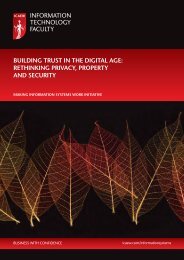Security Effectiveness Framework Study
Security Effectiveness Framework Study
Security Effectiveness Framework Study
Create successful ePaper yourself
Turn your PDF publications into a flip-book with our unique Google optimized e-Paper software.
<strong>Security</strong> <strong>Effectiveness</strong> <strong>Framework</strong> study<br />
The inputs are an organisation’s security technology,<br />
operations, governance and budget. Organisational<br />
characteristics (moderating variables) have been shown<br />
to influence the effectiveness of a security function.<br />
For example, perceptions that trust is important can<br />
support an organisational culture that respects privacy<br />
and data protection. Strategic organisations are more<br />
likely to believe in the importance of having a CISO or<br />
high-level security professional as someone to lead the<br />
security initiatives. The result of these inputs and organisational<br />
variables are six security effectiveness metrics as<br />
described in Figure 1.<br />
The first part of the survey is used to determine how<br />
respondents perceive their organisation. As shown in<br />
Figure 2, the majority say that their organisation can be<br />
characterised as trusted and not risk averse. Less than<br />
half believe their organisation is efficient, strategic and<br />
innovative.<br />
Table 1 provides the aggregated average rating for the<br />
present sample of 101 respondents. The computation<br />
for each item is simply a weighted average (where 2<br />
points are assigned for a very confident response, 1 for a<br />
confident response, -1 for a not confident response and<br />
-2 for unable to accomplish response). 1<br />
Strategic organisations are more<br />
likely to believe in the importance of<br />
having a CISO or high-level security<br />
professional as someone to lead<br />
the security initiatives.<br />
The second part of the benchmark survey instrument asks<br />
questions about the security environment in their organisations.<br />
The survey consists of separate statements that<br />
define reasonable security practices according to trusted<br />
certification authorities such as ISO, NIST and others.<br />
Respondents were asked to rate their organisation’s<br />
ability to achieve one of 13 specific security objectives.<br />
Our rating uses a confidence scale from “very confident”<br />
that the organisation accomplishes a particular security<br />
objective to “not able to accomplish.”<br />
Responses to the 13 items are then scored from a +2 for<br />
a very confident response to -2 for not able to accomplish<br />
response. The average of all 13 questions defines the<br />
security effectiveness score (SES) for the respondent’s<br />
organisation. This average from all respondents is used<br />
in the research as a surrogate for security effectiveness,<br />
which is one of the moderating variables shown in<br />
Figure 1.<br />
Figure 3 reports the distribution of the SES for 101 organisations<br />
in ascending order. As can be seen, the average<br />
SES for the present sample is .08. The highest SES is 1.9<br />
and the lowest SES is -1.8.<br />
60%<br />
50%<br />
40%<br />
30%<br />
52%<br />
20%<br />
50% 47% 45% 43%<br />
Figure 10% 2: Respondents’ attributions about their organisation<br />
0%<br />
60%<br />
50%<br />
Trusted Risk taking Efficient Strategic Innovative<br />
40%<br />
30%<br />
52%<br />
20%<br />
50% 47% 45% 43%<br />
10%<br />
0%<br />
Trusted Risk taking Efficient Strategic Innovative<br />
Figure 3: Distribution of SES for present sample<br />
2.0<br />
1.9<br />
1.5<br />
1.0<br />
0.5<br />
0.08<br />
0.0<br />
-0.5<br />
-1.0<br />
-1.5<br />
2.0<br />
1.9<br />
1.5<br />
-2.0<br />
-1.8<br />
1.0<br />
0.5<br />
SES Average<br />
0.08<br />
0.0<br />
-0.5<br />
-1.0<br />
-1.5<br />
-2.0<br />
-1.8<br />
1<br />
Ponemon Institute developed the SES methodology in partnership with PGP Corporation. It was first used in the 2005 Encryption Trends<br />
<strong>Study</strong>. Since then, the SES has been used in more than 50 Ponemon Institute studies.<br />
SES<br />
Average<br />
Sponsored by: HP Information <strong>Security</strong> and Check Point Software Technologies Ltd.<br />
Ponemon Institute © Research Report & InstrumentPonemon Institute © Research Report & Instrument



